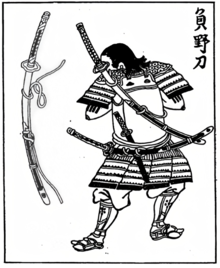Ōdachi
This article needs additional citations for verification. (February 2010) |

An ōdachi (大太刀) (large/great sword) or nodachi (野太刀, field sword)[1][2][3] was a type of traditionally made Japanese sword (nihonto)[4][5] used by the samurai class of feudal Japan. The Chinese equivalent and 'cousin' for this type of sword in terms of weight and length is the Miao dao, and the Western battlefield equivalent (though less similar) is the Spanish Espada Bastarda[6] or Scottish Claymore.
The character for ō (大) means "big" or "great".[7] The dachi here (太刀) is the same as tachi (太刀, lit. "great sword"), the older style of sword/mounts that predate the katana. The chi is also the same character as katana (刀) and the tō in nihontō (日本刀 "Japanese sword"), originally from the Chinese character for a blade,[8] dāo.[9]
To qualify as an ōdachi, the sword in question would have a blade length of around 3 shaku (35.79 inches or 90.91 cm); however, as with most terms in Japanese sword arts, there is no exact definition of the size of an ōdachi.
Purpose
Practically speaking, the function/use of most ōdachi fall into the first two categories—as ceremonial objects and cavalry swords. The possible functions of the ōdachi can be categorized as follows:
- As a votive offering to a shrine (or specifically to its patron gods). Some ōdachi were used in prayer before a war, while others were displayed (sometimes in temples)—reputedly as legendary swords from mythology.
- The average length of an ōdachi is 65–70 inches long (approx 165–178 cm), often with a 4–5 foot (approx 120–150 cm) blade. This made them unsuitable for close-quarters combat. Instead, they are commonly believed to have been used by cavalrymen, as the blade length would allow them to take down infantry (without risk of being pulled off their mount).
- Like other trends, ōdachi were often in vogue, most notably during the Edo Period, so it was not uncommon to see the swords used in various ceremonies.
Production

Ōdachi are difficult to produce because their length makes traditional heat treatment more complicated: The longer a blade is, the more difficult (or expensive) it is to heat the whole blade to a homogenous temperature, both for annealing and to reach the hardening temperature. The quenching process then needs a bigger quenching medium because uneven quenching might lead to warping the blade.
The method of polishing is also different. Because of their size, Ōdachi are usually hung from the ceiling or placed in a stationary position to be polished, unlike normal swords which are moved over polishing stones.
In the past, acquiring a fully sharpened Ōdachi was difficult, as they required special custom orders. In modern times though, many forges in Japan and China are accepting such orders due to the renewed popularity and interest in ancient Japanese weaponry in the late 20th and early 21st centuries.
Method of use

As battlefield weapons, ōdachi were too long for samurai to carry on their waists like normal swords. There were two methods in which they could be carried: One was to carry it on one's back. However, this was seen as impractical as it was impossible for the wielder to draw it quickly. The other method was simply to carry the sheathed ōdachi by hand. The trend during the Muromachi era was for the samurai carrying the ōdachi to have a follower to help draw it.
An exception exists though. The Kōden Enshin-ryū taught by Fumon Tanaka use a special drawing technique for "short" Ōdachi allowing to carry it on the waist. The technique is to pull out the sheath rather than drawing the blade. Even though this move is also used in other schools, like Yagyū Shinkage-ryū, Shin musō Hayashizaki-ryū and of course, modern Iaidō, only Enshin-ryū seems to use it to improve the Ōdachi drawing speed, the other schools using it with classical katana. The Kage-ryū style is also used to draw from the belt, using blades of approximately 2.8 shaku.
Ōdachi swordplay styles differed from that of other Japanese swords, focusing on downward cuts.
Reasons for loss of popularity
The ōdachi's importance died off after the Siege of Osaka of 1615 (the final battle between Tokugawa Ieyasu and Toyotomi Hideyori). Since then, it has been used more as a ceremonial piece.[citation needed]
This loss of popularity is due to the Shogunal government setting a law which prohibited holding swords above a set length (in Genna 3 (1617), Kan'ei 3 (1626) and Shōhō 2 (1645)). After the law was put into practice, ōdachi were cut down to the shorter legal size. This is one of the reasons why ōdachi are so rare.[citation needed] Ōdachi were no longer of practical use, but were still made as offerings to Shinto shrines. This became their main purpose. Due to the amount of skill required to make one, it was considered that their exotic appearance was suitable for praying to the gods.
See also
References
- ^ Classical weaponry of Japan: special weapons and tactics of the martial arts, Serge Mol, Kodansha International, Jun 17, 2003 P.17
- ^ Samurai fighting arts: the spirit and the practice, Fumon Tanaka, Kodansha International, Jun 16, 2003 p.12
- ^ State of war: the violent order of fourteenth-century Japan, Thomas Conlan, Center for Japanese Studies, University of Michigan, 2003 P.260
- ^ The Development of Controversies: From the Early Modern Period to Online Discussion Forums, Volume 91 of Linguistic Insights. Studies in Language and Communication, Author Manouchehr Moshtagh Khorasani, Publisher Peter Lang, 2008, ISBN 3039117114, 9783039117116 P.150
- ^ The Complete Idiot's Guide to World Mythology, Complete Idiot's Guides, Authors Evans Lansing Smith, Nathan Robert Brown, Publisher Penguin, 2008, ISBN 1592577644, 9781592577644 P.144
- ^ es:Espada bastarda[better source needed]
- ^ http://en.wiktionary.org/wiki/大
- ^ http://en.wiktionary.org/wiki/太
- ^ http://en.wiktionary.org/wiki/刀
